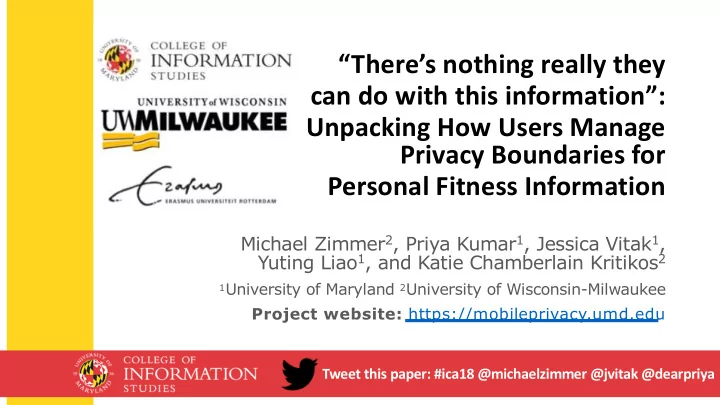

“There’s nothing really they can do with this information”: Unpacking How Users Manage Privacy Boundaries for Personal Fitness Information Michael Zimmer 2 , Priya Kumar 1 , Jessica Vitak 1 , Yuting Liao 1 , and Katie Chamberlain Kritikos 2 1 University of Maryland 2 University of Wisconsin-Milwaukee Project website: https://mobileprivacy.umd.edu Tweet this paper: #ica18 @michaelzimmer @jvitak @dearpriya
What do we mean by the quantified self ? Self-knowledge through self-tracking using technology. Tweet this paper: #ica18 @michaelzimmer @jvitak @dearpriya
Fitness trackers are increasingly designed to be worn unobtrusively on the body—and to collect data constantly while worn. Tweet this paper: #ica18 @michaelzimmer @jvitak @dearpriya
Tracking Every Breath You Take & Every Move You Make Fitness trackers collect a lot of data Ø Steps taken Ø Distance traveled Ø Floors climbed Ø Calories burned Ø Time slept Ø Heart rate Ø Activity/workout statistics Ø Location/GPS (sometimes) Tweet this paper: #ica18 @michaelzimmer @jvitak @dearpriya
Inferring Behavior from Data Ø Dietary habits Ø Stress levels Ø Alcohol use Ø Exposure to pollutants Ø Social context Ø Movement patterns … … … Ø Insurance rates? Ø Fidelity? feltron.com Tweet this paper: #ica18 @michaelzimmer @jvitak @dearpriya
Research Questions RQ1 : What benefits and drawbacks do users experience from using fitness trackers? RQ2 : How do users of fitness trackers perceive concerns over privacy and personal fitness information? RQ3 : What actions, if any, do users take to manage the privacy of their personal fitness information? Tweet this paper: #ica18 @michaelzimmer @jvitak @dearpriya
Method: Sampling Random sample of 6000 university staff invited to participate in study if they owned a Fitbit/Jawbone Ø 363 completed surveys Ø Survey invited participants to enter email to participate in future studies (141 participants did this) For analysis of survey results, see: Vitak, J., Liao, Y., Kumar, P ., Zimmer, M., & Kritikos, K. (2018). Privacy attitudes and data valuation among fitness tracker users. Proceedings of the 13th Annual iConference, Lecture Notes in Computer Science, vol 10766. (pp. 229-239). London: Springer. https://doi.org/10.1007/978-3-319-78105-1_27 Tweet this paper: #ica18 @michaelzimmer @jvitak @dearpriya
Method: Interview Participant Selection Divided potential interviewees into four categories: Ø High Skill/High Concern Ø High Skills/Low Concern Ø Low Skill/High Concern Ø Low Skill/Low Concern Used criterion sampling (Patton, 2005) to select participants evenly across four categories. Final dataset includes 33 interviews across were analyzed through iterative coding process by all five authors (Lincoln & Guba, 1985). Tweet this paper: #ica18 @michaelzimmer @jvitak @dearpriya
Interview Highlights: Perceived Benefits Ø Trackers as part of daily routine Ø Trackers as personal motivator Ø Benefits beyond step tracking Look how happy Fitbit makes people! Tweet this paper: #ica18 @michaelzimmer @jvitak @dearpriya
Interview Highlights: Perceived Drawbacks Ø In general, users perceived few drawbacks to these devices Ø Lack of interest in social and gamification aspects Ø Social comparison can be problematic Do you ever even sleep, Suzi? Tweet this paper: #ica18 @michaelzimmer @jvitak @dearpriya
Interview Highlights: Privacy Concerns & PFI Ø Most participants had minimal privacy concerns “If this information was public, I wouldn’t be upset about their PFI (one-third by it. If anybody wants to said they had none) know how much water I drink, wow, they need Ø Some had not considered to get a life.” (P69) how PFI could be used for broader purposes Ø Data is seen as innocuous and not sensitive Tweet this paper: #ica18 @michaelzimmer @jvitak @dearpriya
Interview Highlights: Privacy Concerns & PFI Boundaries did exist for “If you had exactly the number of steps problematic data collection someone took at which time, you can and sharing. actually work out exactly what they did and it kinda gets into the personal space where they got up in the morning and then went to Ø Name: Probably OK the bathroom. I think that invades my Ø Steps: OK personal space where something personal Ø Sleep: Maybe OK to me being exposed to someone else.” (P75) Ø Location: Not OK Ø DOB: Not OK Ø Granular data: Not OK Tweet this paper: #ica18 @michaelzimmer @jvitak @dearpriya
Interview Highlights: Privacy Behaviors ü Low privacy concerns à minimal engagement with privacy features ü Rely on default settings ü Differences between app and web dashboard settings Tweet this paper: #ica18 @michaelzimmer @jvitak @dearpriya
Fitbit’s Website Account Privacy Settings Fitbit’s Mobile App Privacy Settings Tweet this paper: #ica18 @michaelzimmer @jvitak @dearpriya
Theoretical Implications We considered these interviews in light of Petronio’s (2002) Communication Privacy Management (CPM) theory. 1. Ownership ü Thick boundary: Users want to own their PFI ü Thin boundary: Users do not change default privacy settings 2. Privacy rules ü Users share only basic PFI and only share with known social ties ü Users inherently trust fitness tracker companies 3. Turbulence ü Unaware of unanticipated sharing PFI with third parties Tweet this paper: #ica18 @michaelzimmer @jvitak @dearpriya
Conclusions and Future Research We hypothesize that fitness tracker users : Ø View the devices as a personal utility (even a toy) Ø Do not engage in social activities, thus don’t include trackers within set of concerns about social media privacy Ø Don’t concern themselves with how data is being collected, aggregated, shared This leads to a normalization of data collection and aggregation, with little concern over data sensitivity. Tweet this paper: #ica18 @michaelzimmer @jvitak @dearpriya
Thanks! Jessica Vitak College of Information Studies University of Maryland jvitak@umd.edu https://pearl.umd.edu https://jessicavitak.com This material is based upon work supported by the National Science Foundation under Grant Number 1640640. Tweet this paper: #ica18 @michaelzimmer @jvitak @dearpriya
Recommend
More recommend